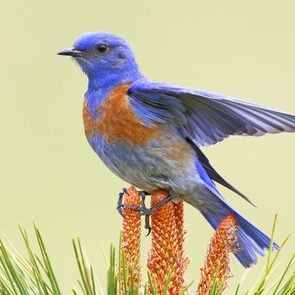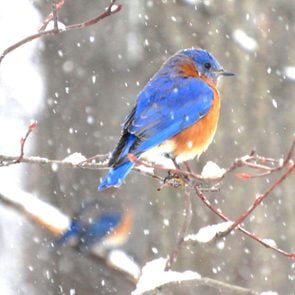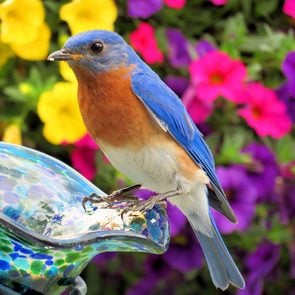On This Page
How Do Birds Use Their Feet?
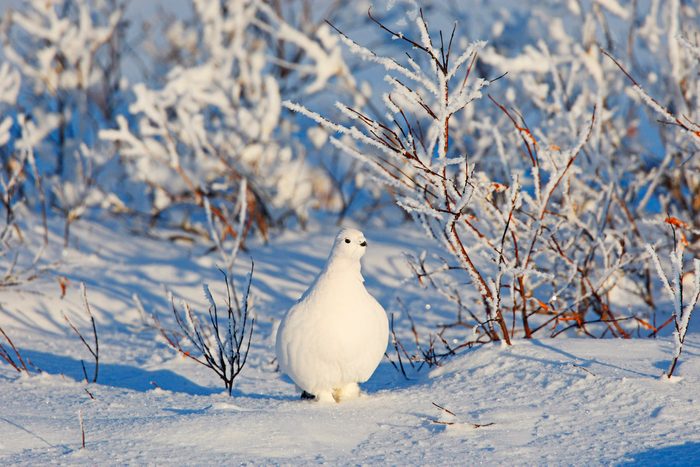
As bird lovers, we spend a lot of time in awe of birds for their brightly patterned plumage, wing shapes and entertaining antics, not to mention that they can fly. But when not soaring through the sky, birds rely on their specially structured feet to get around. Their unique toes come in arrangements such as zygodactyl and anisodactyl, which may sound more like names of their dinosaur cousins, but don’t worry! You can still appreciate just how crucial birds’ feet really are. No scientific memorization required!
Learn all about hummingbird feet: can hummingbirds walk?
Bird Feet and Toes for Perching

Many backyard birds, from robins to wrens and phoebes to finches, belong to a large group called perching birds. The structure of their feet helps them perch on thin twigs. These birds have three toes pointing forward and one pointing backyard, an anisodactyl arrangement, so each foot touches the perch at four separate points.
When birds settle on a twig, their toes automatically tighten, thanks to the muscles in the legs and feet. Similarly, when birds rise up, the toes loosen their grip. Chickadees that flit from branch to branch may grasp and release different perches thousands of times a day.
Bird anatomy 101: here’s what you need to know.
Bird Feet for Climbing Trees

Woodpeckers, nuthatches and creepers are common tree-climbing birds. Their powerful gripping toes help them cling snugly to bark or dead wood.
Learn all about bird wings and flight feathers.
Bird Feet and Toes for Walking
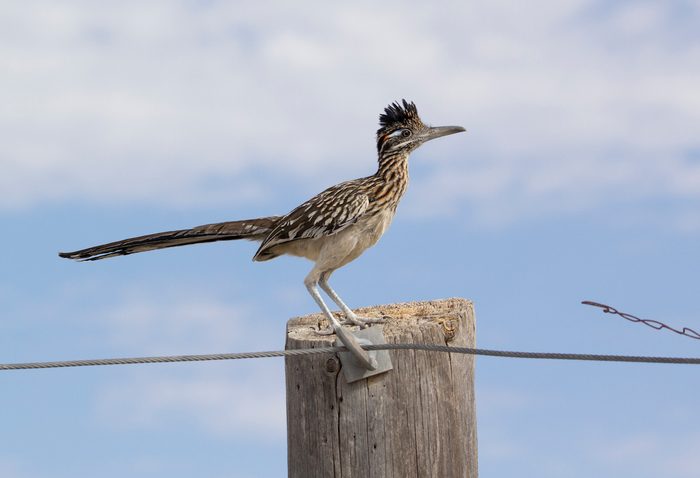
Wild turkeys and ring-necked pheasants walk more than fly, and have strong, sturdy legs and toes. Males of both species have a spur on the back of the leg, which they may use when they get into fights. It’s typical for birds that spend a lot of time on the ground, especially hard ground, to have strong feet.
Another bird known for strong legs is the greater roadrunner of the desert Southwest. This bird has zygodactyl feet (two toes pointing forward and two backyard). It leaves X-shaped tracks, and Native American legends celebrated the fact that no one could tell from the tracks which way the bird was going. True to its name, the roadrunner can run at 20 miles per hour for quite a distance.
The ultimate walking bird is probably the ostrich, the tallest bird in the world. Its small wings are useless for flight, but it has huge, muscular legs and feet. While most birds have four toes and a few have three, ostriches are the only birds in the world with only two toes on each foot.
Learn about 6 bird beak types and how birds use them to eat.
Bird Feet for Swimming
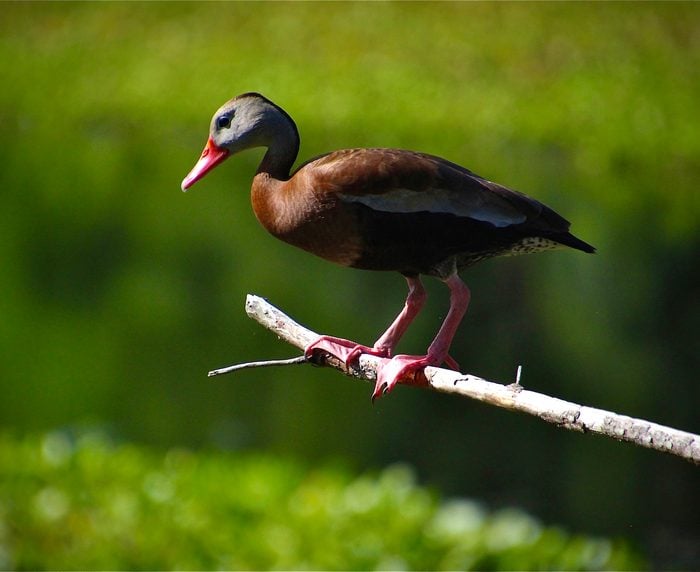
Birds that swim have special requirements. They paddle with their feet to move across the water’s surface, but the skinny little toes of a typical bird wouldn’t be useful for pushing against water. However, with webbing stretched between the toes, those feet become very effective fins. The webbed feet of ducks, geese, and swans are widely known, but we also see webbed feet on many unrelated waterbirds, such as pelicans, loons, and gulls.
Some waterbirds have only partial webbing, often in the form of expanded lobes or flaps along the edges of the toes. The bizarre feet of the American coot offer an interesting example. Those lobed toes are good for swimming, and they’re also suited for walking on land. However, grebes rarely come out on land, and they also have lobbed toes.
Bird Feet and Toes for Uneven Surfaces
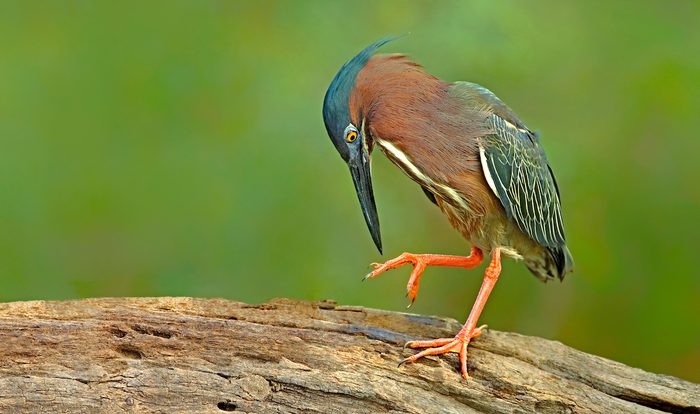
Birds can’t walk on water; but some marsh birds come close, with long toes that allow them to traipse across the surface of very wet mud or floating plants. We see this long-toed shape on various herons, rails, and sandpipers. The extreme examples are found on tropical shorebirds called jacanas. Their ridiculously long toes allow jacanas to walk around easily on top of floating lily paps. In fact, “lily-trotter” is one nickname for them. One species, the northern jacana, shows up in southern Texas at times.
What about walking on frozen water? Ptarmigan are small grouse that live in the far north and high mountains, regions covered with deep snow for much of the year. Like other grouse, they have fairly short toes. But ptarmigan grow a fringe of stiff feathers along the sides of their toes, which act like snowshoes, allowing them to walk across the surface of soft, fluffy snow.
Bird Feet for Feeding
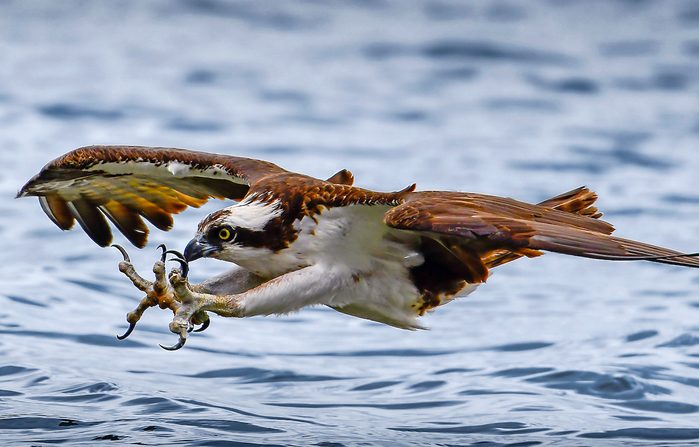
The word “raptor” comes from a root word that means “to seize and carry away.” Hawks, falcons, and owls have strong toes and long, sharp, curves claws, specialized for hunting, capturing, and carrying prey. Most birds use their feet for sitting in one place or moving around, but for these birds of prey, their feet are their essential tools.
Most hawks and falcons have three forward toes and one back toe. On owls, however, the outer toe is reversible: It usually swivels to the back when the owl is perched or grasping prey, giving it a zygodactyl arrangement with two toes forward and two back, but sometimes it perches with three toes forward.
And then there’s the osprey, which also has this reversible outer toe. The osprey, or fish hawk, is famous for diving feet-first into water to catch fish. Besides being able to swivel its outer toe around, the osprey also has very rough scales on the soles of its toes, which likely help it keep a firm grip on slippery fish.
Raptors are big enough that you can easily see their claws, but the structure and look of songbirds’ feet is often overlooked. Head outside and observe how even the most common birds in your backyard get around when they’re not flying. It’s proof that from their feathers to their toes, birds are endlessly fascinating.
Brightly Colored Bird Feet
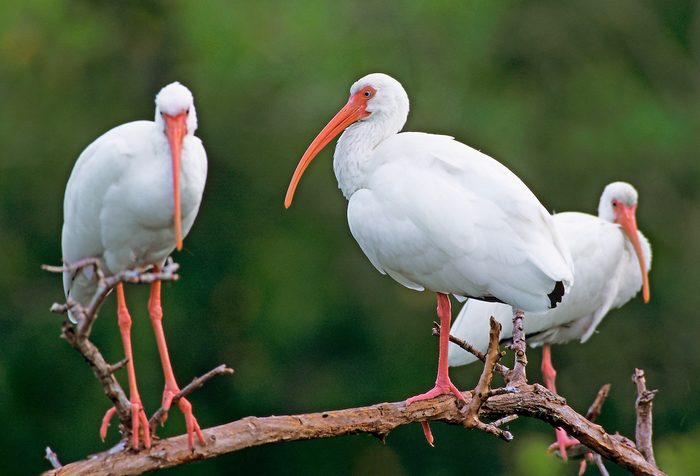
Bird feet tend to have dull, dark colors, but here are a few that flaunt bright hues.
- Snowy egret: Black legs and yellow feet
- Blue-footed booby: You can guess this one!
- Least bittern: Greenish-yellow legs and feet
- Louisiana waterthrush: Bubblegum pink feet
- Blackpoll warbler: Yellow feet
- Horned puffin: Orange feet
- White ibis: Red legs and feet
Why Trust Us
For nearly 30 years, Birds & Blooms, a Trusted Media Brand, has been inspiring readers to have a lifelong love of birding, gardening and nature. We are the #1 bird and garden magazine in North America and a trusted online resource for over 15 million outdoor enthusiasts annually. Our library of thousands of informative articles and how-tos has been written by trusted journalists and fact-checked by bird and garden experts for accuracy. In addition to our staff of experienced gardeners and bird-watchers, we hire individuals who have years of education and hands-on experience with birding, bird feeding, gardening, butterflies, bugs and more. Learn more about Birds & Blooms, our field editor program, and our submission guidelines.
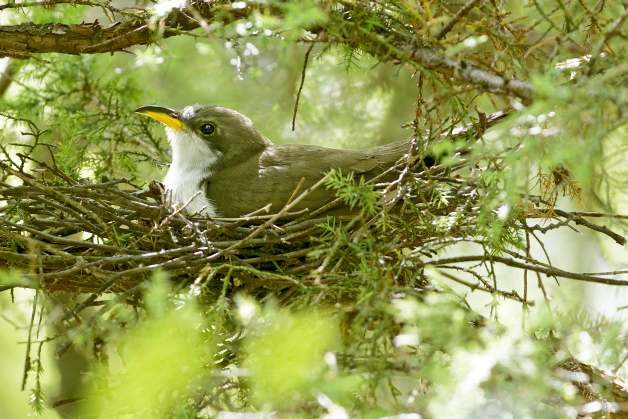
Try your hand at bird landscaping, and you’ll quickly learn that landscaping is for the birds—literally! Planting with birds in mind pays off fast, attracting birds in greater numbers with more variety and longer visits from your feathered friends. It’s easy, too. All it takes is looking at your yard from a bird’s point of view.
You’ll have greater success at attracting your favorite species when you realize two things–finding food and not getting eaten–are the two biggest issues for birds. Food is the first step to winning the hearts of birds, and keeping a feeder makes you feel good, too. To really bring in the birds, you need to make them feel at home in your yard. And the way to do that is by growing plants for nesting birds.
Bird landscaping or birdscaping, as some people call it, is a lot simpler than it sounds. All it takes are some common sense and a few lessons from the very best gardener of all, Mother Nature.
On This Page
Bird Landscaping Basics
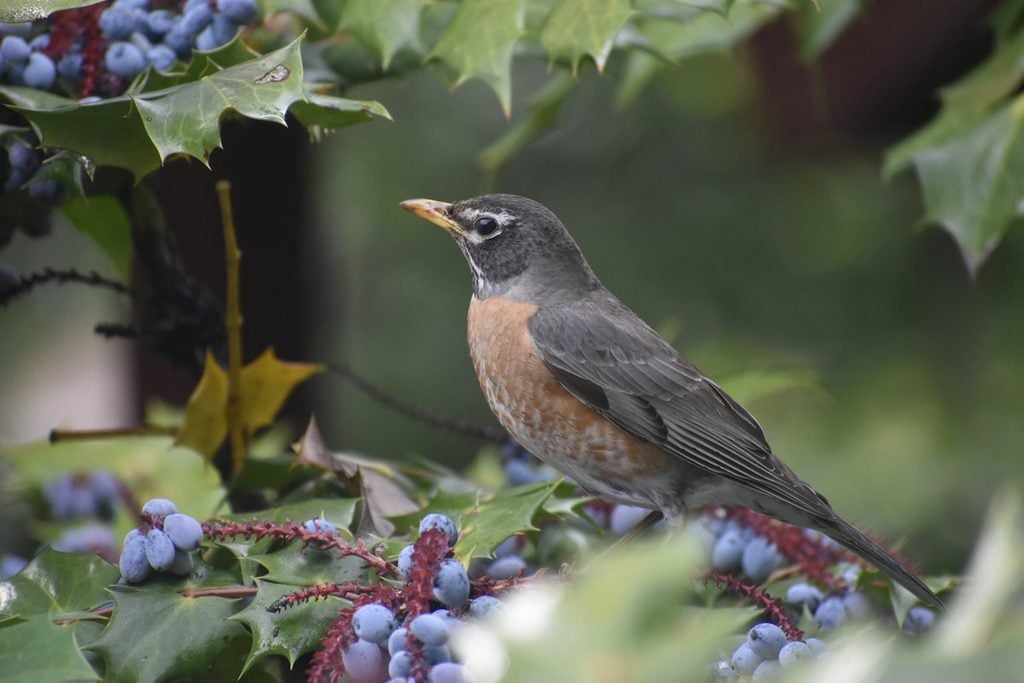
Imitate natural wild areas, and you’ve got it made. You could just let your whole backyard go wild; birds would heartily approve. But most of us like to keep some sense of order, so try these bird landscaping tricks to keep both you and your feathered friends happy.
- Plant shrubs for nesting birds in groups of three or more, to build larger areas of cover.
- Spread a thick layer of mulch beneath and between shrubs. Instantly, you’ve made an inviting foraging area for towhees, robins, native sparrows and juncos.
- Add a hedge along a boundary or your privacy fence. Include thorny shrubs, such as roses or flowering quince, to provide tempting nesting places for brown thrashers, gray catbirds, cardinals and others.
- Plant evergreen shrubs and trees such as holly, rhododendron, and spruce to offer shelter from the weather.
- Vary the height of your flower beds and boost their bird appeal by planting small trees, such as dogwood and redbud, right in the beds.
The Perfect Plants for Your Bird Landscape
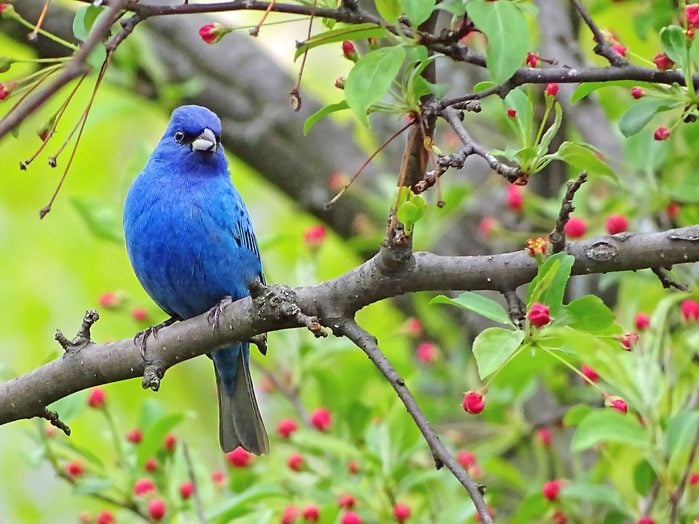
You can find hundreds of specific plants to attract birds, but how do you get started finding them? This general list will steer you in the right direction.
- Native trees or shrubs
- Flowering crabapples, hawthorns
- Fruit trees or bushes
- Junipers
- Pines or spruces
- Other flowering trees and shrubs
Trees for Birds That Eat Insects
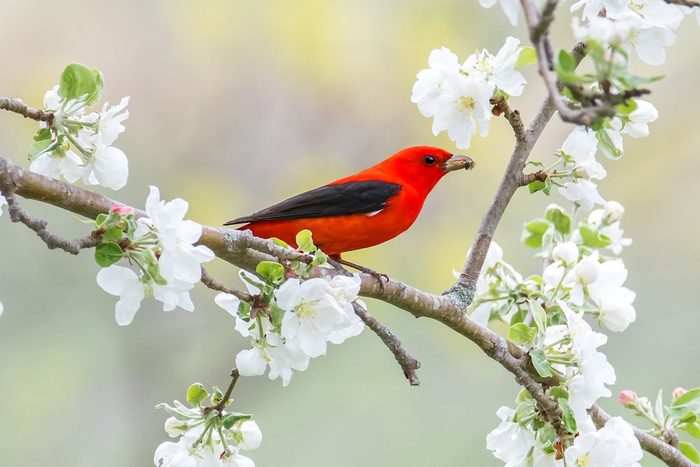
Talk about multitasking—the plants in our yards do it all. They supply vital protective cover, shelter birds in bad weather and serve as nesting places.
And that’s not all. Many plants also serve up enough natural food—seeds, fruit, berries and especially bugs—to keep birds coming back day after day.
Insects are the natural food our feathered friends rely on year-round. A big banquet of them will draw in birds of all kinds, just as feeders do.
To boost your bugs—yep, more insects is a good thing, if you want birds—add spring-flowering trees to your yard. Crabapples and other fruit trees bloom at migration time. That makes them an inviting pit stop for traveling warblers, vireos, gnatcatchers, tanagers, orioles and other birds that recognize the opportunity for an insect feast.
Native Plants for Birds That Eat Caterpillars
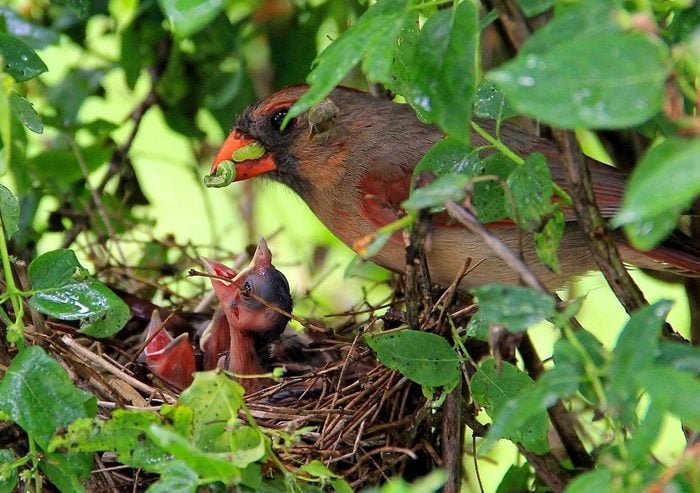
Caterpillars are another can’t-miss menu item for birds. They’re at their peak during nesting season, just in time to stuff down a bunch of gaping beaks. No need to research good plants for caterpillars—just go native. Many native trees, shrubs and other plants serve as hosts for egg-laying butterflies or moths, as well as nurturing a plethora of other insects.
Trees and Bushes for Birds That Eat Berries
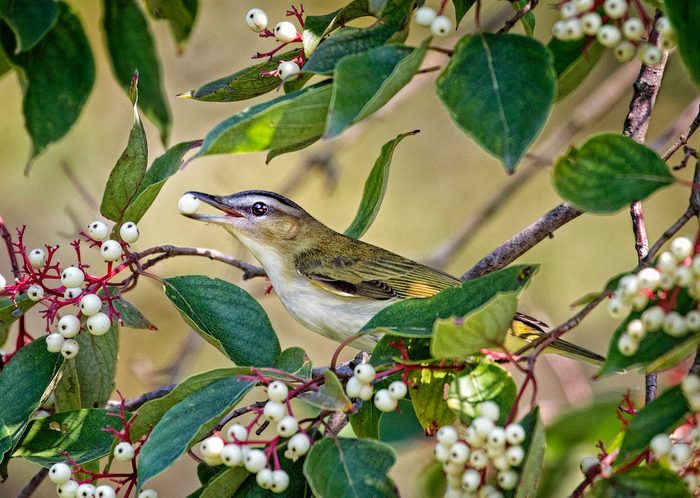
Ask any bird lover what plants are best for nesting birds, and the answer is likely to be berry bushes. A hedge of mixed berry bushes is irresistible to bluebirds, thrashers, catbirds and other friends. Groups of shrubs with just a hop, skip and jump between them are also great.
Birds somehow know when the fruit crop is ready, and it’s quite a thrill when our favorite songbirds start winging their way in from miles around.
Still, it takes only a week or so until the birds have gobbled every berry. The show is over until the next fruit or berry in your yard starts to ripen.
I wouldn’t be without berry bushes or fruit trees in my yard. But I look beyond the harvest, and so do the birds. Any fruit or berry we plant is going to be home to bugs. Even if they escape our notice, birds will find them. Plus, like any plant we find a place for, berry bushes will add to the available cover, and maybe even cradle a cardinal nest come spring.
Bird Landscaping for Predator Protection
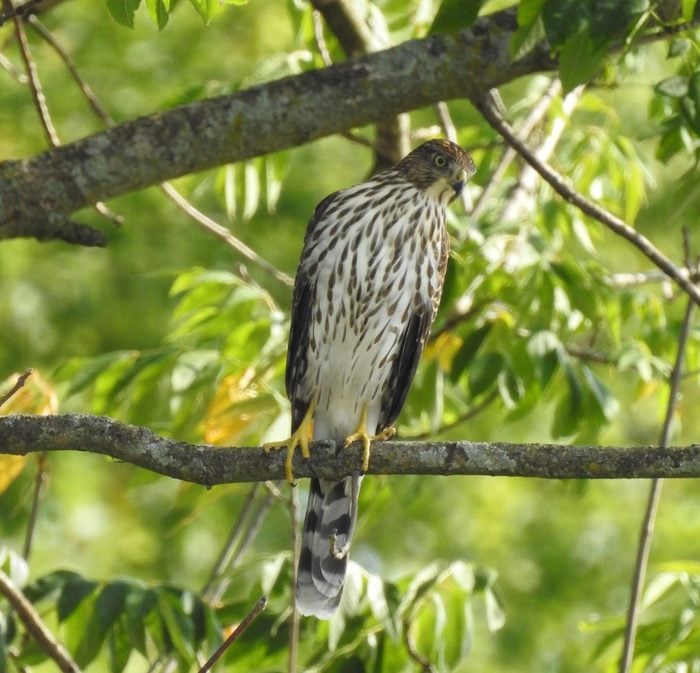
You can learn a lot about planning for birds just by watching them in their natural surroundings. Observe them in your yard, and you’ll see that very few of them spend time out in the open. Most of our friends stay under cover as much as they can to boost their chances of survival. They alight in trees, gather in bushes or scoot through the garden looking for food. The sheltering branches or stems protect them from the hungry eyes of predators.
A stalking cat may rush a robin on the lawn. A hungry hawk may drop from the sky at any moment. Vulnerable nestlings, eggs or even parent birds on the nest may be the target of a prowling raccoon or slithering snake.
So think like a wary bird and set up stepping-stones of shrubs, trees, grasses and flower beds. Go horizontal with corridors of plants so birds can move easily about your yard.
But think vertically, too, because birds move up and down as well as sideways. You can shoehorn in a surprising amount of cover by layering small trees, shrubs, ferns and ground covers near big trees, and by adding an arbor or trellises for vines and roses. Your backyard will soon look like an oasis, especially from the air.
Check out the best plants that attract birds in all seasons.
Skip Pesticides
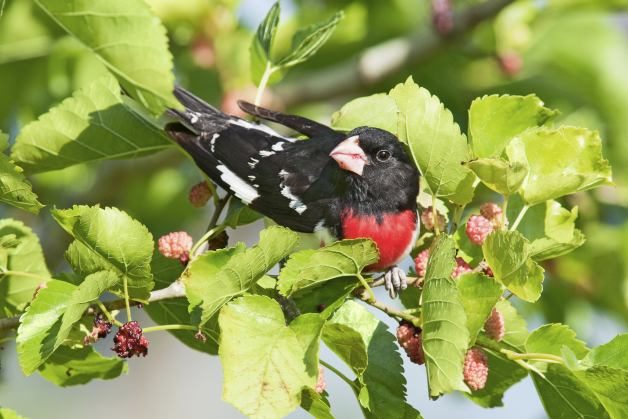
Of course, you’ll want to avoid pesticides as much as possible in your bird paradise. Just think of those pesky bugs as bird food, and be patient until the troops arrive. Chickadees, wrens and vireos will help you out with aphids. Cardinals and rose-breasted grosbeaks snap up potato beetles. And starlings are your best friends when it comes to Japanese beetles: They’re searching for grubs when they waddle about, stabbing the ground.
Don’t Clean Up Too Much
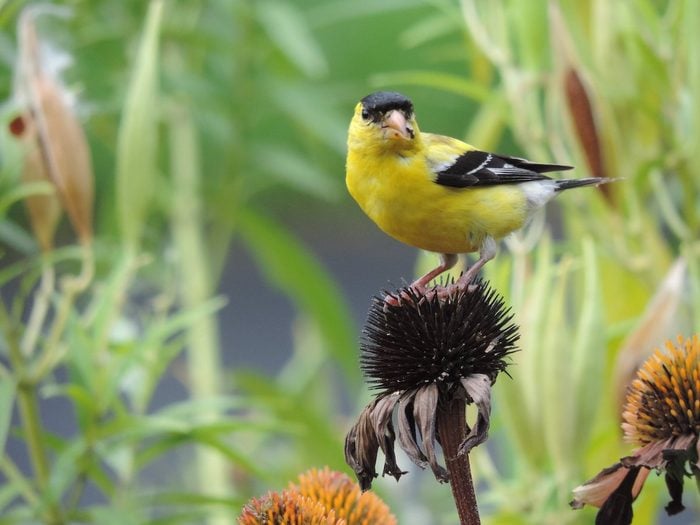
While most gardeners strive for neatness, birds like messy surroundings, so bird landscaping focuses on finding a happy medium—a natural look that will coax birds into lingering and possibly even nesting. Let perennials, shrubs and other plants knit together, instead of keeping bare space around every plant. Allow the dead leaves to lie beneath shrubs and hedges as an insect-rich mulch for gray catbirds, thrashers, wrens and other friends to investigate.
Hold off on cutting back flower beds until spring so goldfinches, titmice, doves, quail and other birds can shelter in them when searching for seeds and insects in winter. Instead of getting out the clippers every few months, learn to love the natural look of a free-form hedge. Birds will appreciate it. And you’ll appreciate the birds bringing life to your yard, every season of the year.
Why Trust Us
For nearly 30 years, Birds & Blooms, a Trusted Media Brand, has been inspiring readers to have a lifelong love of birding, gardening and nature. We are the #1 bird and garden magazine in North America and a trusted online resource for over 15 million outdoor enthusiasts annually. Our library of thousands of informative articles and how-tos has been written by trusted journalists and fact-checked by bird and garden experts for accuracy. In addition to our staff of experienced gardeners and bird-watchers, we hire individuals who have years of education and hands-on experience with birding, bird feeding, gardening, butterflies, bugs and more. Learn more about Birds & Blooms, our field editor program, and our submission guidelines.
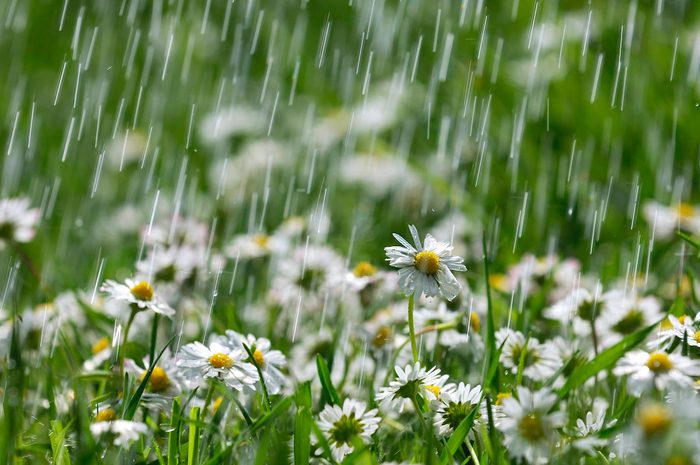
Water—it’s one of the most essential, beneficial and frustrating assets for gardeners throughout the country. At any given time, there seems to be either too much of it or not enough. So what’s the solution? Plant a rain garden!
On This Page
Rain Garden Benefits
No, a rain garden won’t necessarily solve all your planting problems, but it’s one of the most attractive and effective ways to manage inconsistent rainfall in your backyard. The rewards are almost endless: It reduces the risk of flooding and overloading storm sewers, it allows plant roots and soil to filter out impurities before the water goes back into the ground, and it’s just plain good for the environment.
While most trees, grasses and other plants naturally help intercept rainwater, rain gardens can soak up as much as 30 percent more water than conventional lawns. If planned right, they also provide a natural habitat for birds, as well as butterflies and other helpful insects. So start planning your rain garden now, and put rainwater to work for you.
Check out the top 10 water wise plants that will thrive in a dry spell.
Planning Your Rain Garden

For best results, consider a few things up front. Note your soil type, the slope of the garden area, the distance from the house, the average rainfall for your area and the square footage of hard surfaces such as drives, walks or rooftops where you’re collecting water.
You’ll want to prepare your garden on a slight slope and at least 10 feet away from your house to avoid water collecting near your foundation. Also, avoid planting rain gardens over septic systems and under trees, where increased soil moisture could cause damage.
If possible, design the garden with the longest end perpendicular to the slope, increasing the border available to intercept water runoff. The garden should be about twice as long as it is wide. This provides plenty of room for plants to help slow down water and absorb it, as well as making it easier for you to come up with an attractive layout for the area.
Prepare the Site
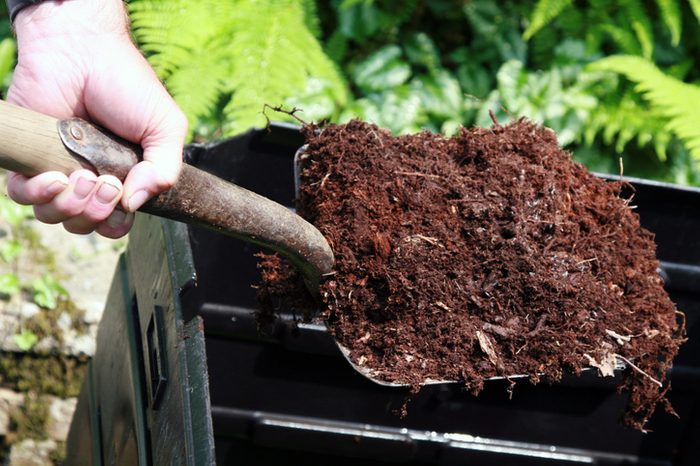
Most rain gardens should be 4 to 8 inches deep, but you’ll need to take the soil type, slope and size of your garden into account. Make sure the garden is level to avoid water pooling on one side.
You may need to move, excavate or add soil to make this happen. It also might help to create a small berm on the downhill edge of the garden to help contain water until it can naturally drain.
Dig several inches of compost or other organic matter into the top 6 to 8 inches of soil before planting. This will improve drainage in heavy soils and increase the water retention of fast-draining soils. This step is really crucial, because natural rainfall supplying water to your garden will often be irregular.
In the end, a well-designed garden will drain within 12 to 48 hours, avoiding standing water. This is important to the health of your plants and to prevent mosquitoes from breeding in your garden.
Psst—check out our guide on how to make compost.
Add Rain Garden Plants
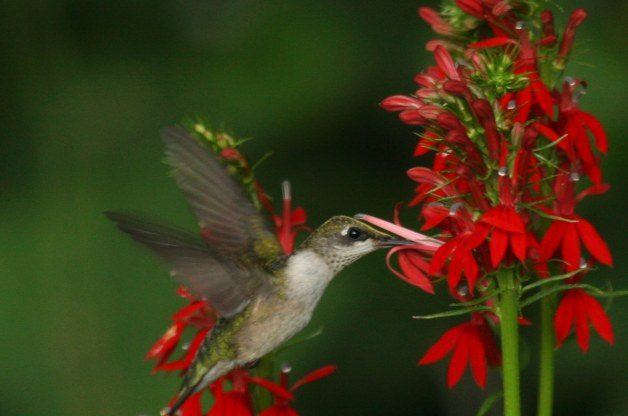
Select plants suited to temporary flooding and drought, since rain gardens are not water gardens, ponds or wetlands. They are designed to capture water during rainfall and quickly drain as plants absorb the moisture and as excess water moves through the garden soil to recharge the groundwater. Ultimately, your goal is to reduce your workload, not increase it.
Begin choosing plants by looking at the native plant species in your area. Plants native to prairies and swamps or other areas subject to flooding and drought are your best bets, but don’t stop there. Also check with nature centers, extension offices and your state department of natural resources to see if they offer regional rain garden suggestions as well.
As you go, use plants with a variety of bloom times for season-long color. Variety is a must. For instance, a mixture of sedges, rushes and other grassy plants make a dramatic backdrop for flowers.
Go lawn free: learn how to plant a prairie garden.
Best Perennials for Rain Gardens
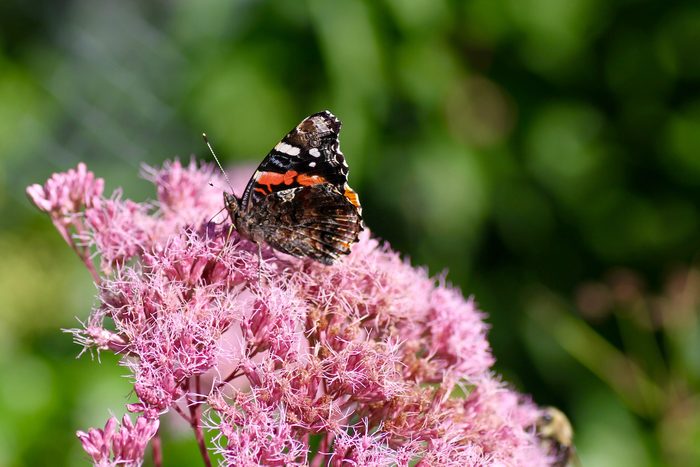
Here some colorful perennials to try:
- Cardinal flower (Lobelia cardinalis)
- Black-eyed Susan (Rudbeckia fulgida)
- Swamp milkweed (Asclepias incarnata)
- Swamp mallow (Hibiscus moscheutos)
- Joe Pye weed (Eupatorium)
- Sedges (Carex)
- Bluestar (Amsonia)
- Turtlehead (Chelone)
Mulch the Soil
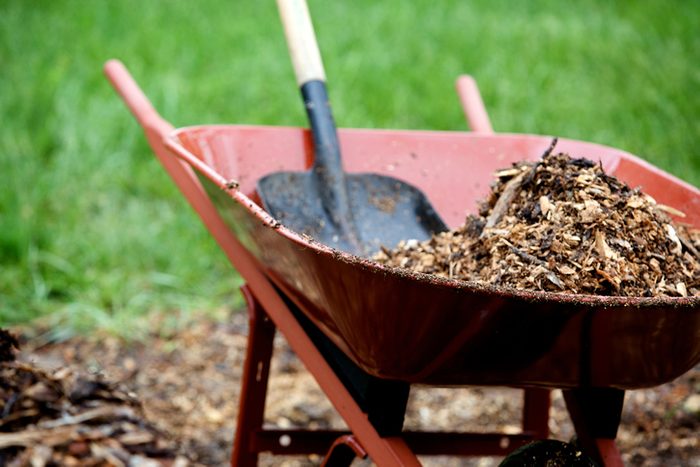
Place moisture lovers in the lowest areas of the garden that tend to stay wetter longer, and plant drought-tolerant species on the sides or edges of the garden.
Once all the plants are in, mulch the garden with twice-shredded bark. This mulch knits together and won’t wash away in the rain. Plus, mulching the soil prevents erosion, conserves moisture during dry spells and suppresses weeds. Be careful not to bury the crowns of the plants, though, because that can lead to rot.
Water Your Rain Garden
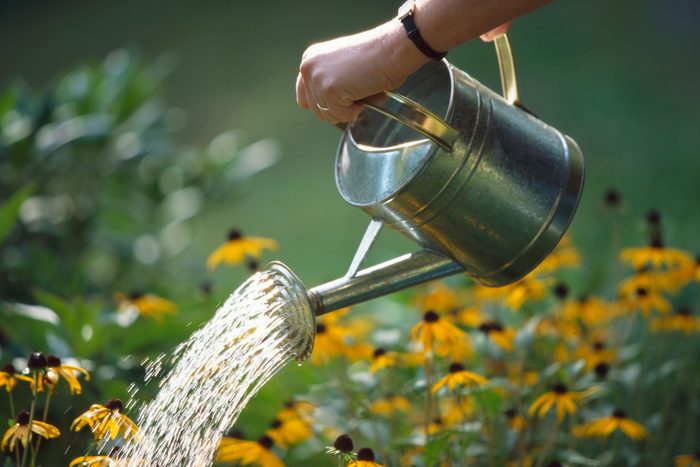
Just because you have a rain garden doesn’t mean you don’t have to water it. Make sure new plantings receive sufficient water, about an inch a week. Adjust the frequency based on the temperature and your soil type. New plantings, even drought-tolerant ones, need regular watering to encourage deep roots that are more efficient at absorbing water.
When is the best time to water plants?
Rain Garden Maintenance
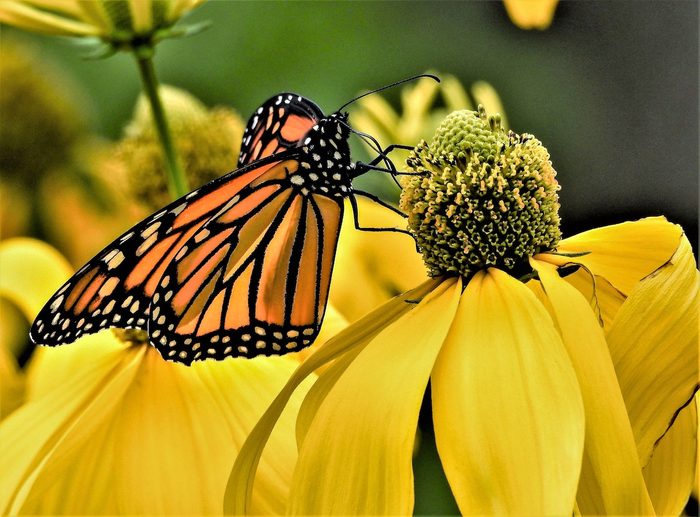
Weed regularly the first few years to allow your desirable plants to get established, fill in and outcompete future weeds. Remove dead growth at the start of each season and cut plants back as new growth begins. For an easy spring cleanup, use a string trimmer or mower you can set higher than the new growth. A hand pruner is best for thicker stems like sunflowers, asters and Joe Pye weed.
It’s not all work and no play, though. Rain gardens are relatively low maintenance once you get them installed and established. So kick back as you enjoy the birds, butterflies and neighbors that visit your garden. You can feel good about doing your part for the environment, one garden at a time.
4 Tips for a Successful Rain Garden
- Do the research and plan. Don’t think you can just put in a rain garden on a whim. It takes careful thought and planning.
- Location does matter. Make sure your garden is at least 10 feet away from the foundation of your house. Don’t plant it under trees, over septic systems or in areas where water might collect.
- Work with your soil. Amend the soil to improve drainage in heavy soils and increase the water retention of porous soils.
- Choose plants carefully. Be sure to pick varieties that tolerate both temporary flooding and drought.
Alternate Ways to Conserve Water in the Garden
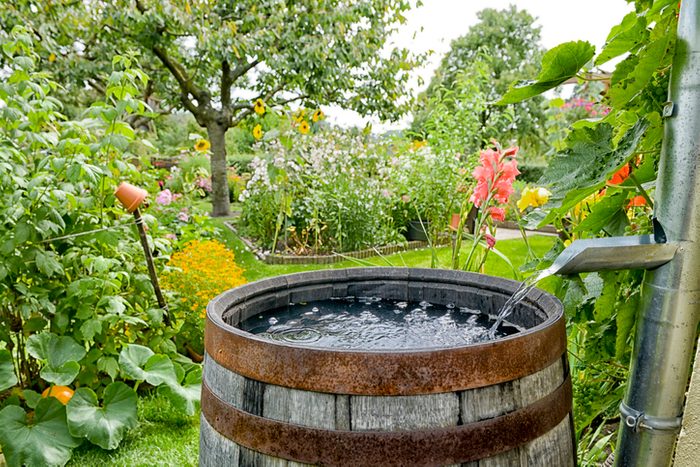
Don’t want to plant a rain garden? Here are some other ideas for conserving water.
- Install rain barrels and cisterns to capture water for use in the landscape
- Use water from dehumidifiers or air conditioners to water container plants
- Use drought-tolerant plants
- Group moisture lovers together
- Mulch soil to conserve moisture
Why Trust Us
For nearly 30 years, Birds & Blooms, a Trusted Media Brand, has been inspiring readers to have a lifelong love of birding, gardening and nature. We are the #1 bird and garden magazine in North America and a trusted online resource for over 15 million outdoor enthusiasts annually. Our library of thousands of informative articles and how-tos has been written by trusted journalists and fact-checked by bird and garden experts for accuracy. In addition to our staff of experienced gardeners and bird-watchers, we hire individuals who have years of education and hands-on experience with birding, bird feeding, gardening, butterflies, bugs and more. Learn more about Birds & Blooms, our field editor program, and our submission guidelines.
Sources
Melinda Myers, official gardening expert for Birds & Blooms
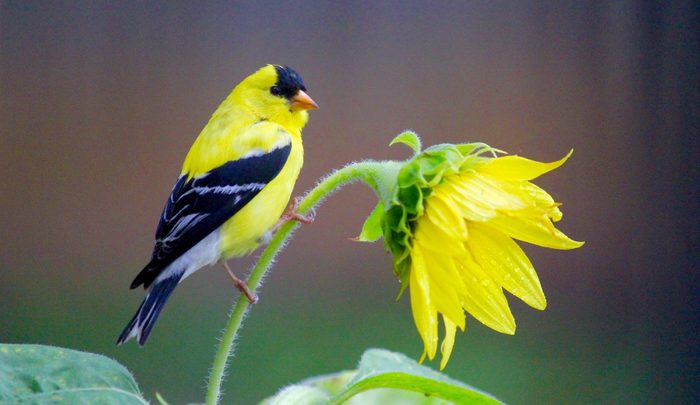
Whether you’re already a dedicated caretaker of backyard feeders or brand-new to birding, it’s always a good idea to kick it up a notch! Native plants that allow you to harvest seeds will attract more birds to your backyard. After all, plants have a lot more to offer than just beautiful flowers. Why not get the most out of your garden by growing birdseed plants to feed your feathered friends?
“Anybody, anywhere they live, can support the birds they love by growing native plants,” says Tod Winston, program manager for the National Audubon Society’s Plants for Birds program.
Check out the National Audubon Society’s Native Plants Database or consult local native plant nurseries to find the best picks for your zone and region.
“The more people who plant native plants in their yard, the more resilient birds are going to be in the face of climate change and in the face of continuing loss of habitat,” Tod says. He adds that nearly 41 percent of all migratory songbird populations in North America are declining.
Sunflowers are an easy-care option that will work in almost every garden. If you’re seeking some variety to beautify your backyard, consider planting other native birdseed plants from the Aster family. Try coneflowers, tickseed and black- and brown-eyed Susans.
On This Page
Sunflowers
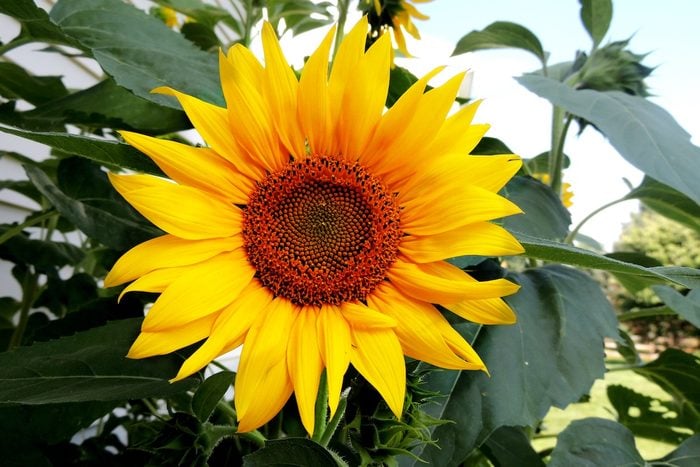
Helianthus annuus, annual
You can’t expect to grow your own birdseed without this classic bird magnet. There are plenty of varieties to choose from, including cultivars that range from 2 to 15 feet tall and colors from yellow to red.
Sunflowers are simple—it doesn’t take much for their seeds to take root. Plant your sunflower seeds in late spring, provide them with plenty of sun and a spot in a patio pot, raised bed or garden, and you’ll soon have a crop of flourishing flowers.
Check out the top 10 sunny sunflower varieties.
Sunflowers benefit many seed-eating birds, including cardinals, grosbeaks, finches, sparrows and more. And their compound flower heads are packed with pollen, so hummingbirds may stop by. These bright beauties also host more than 70 species of native moth and butterfly caterpillars.
That’s a big deal because one nest of Carolina chickadee chicks may eat up to 9,000 caterpillars before fledging. Plus, 90 percent of land birds feed insects to chicks, so it’s important to protect those local populations.
Migrating birds also love the seeds, because they’re high-fat fuel for their journeys south.
Black-eyed Susan
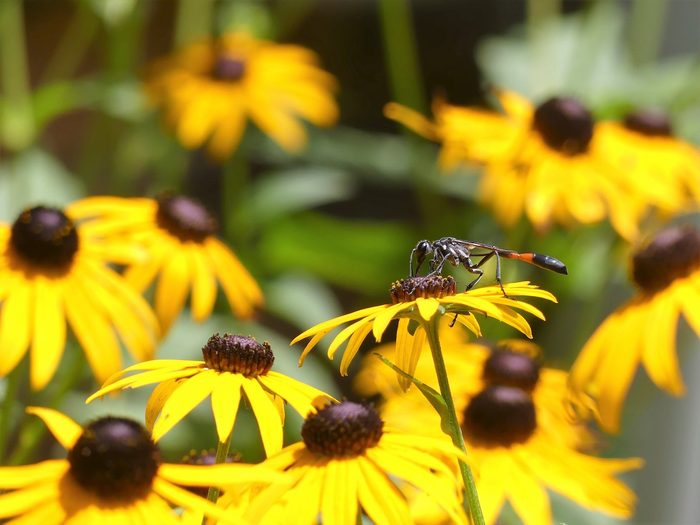
Rudbeckia, Zones 3 to 9
This is another garden classic that birds adore. The traditional black-eyed Susan has dark centers and bright-yellow flowers, but now there are even more varieties to choose from. Grow in full sun to light shade for blooms in summer through autumn.
Blazing Star
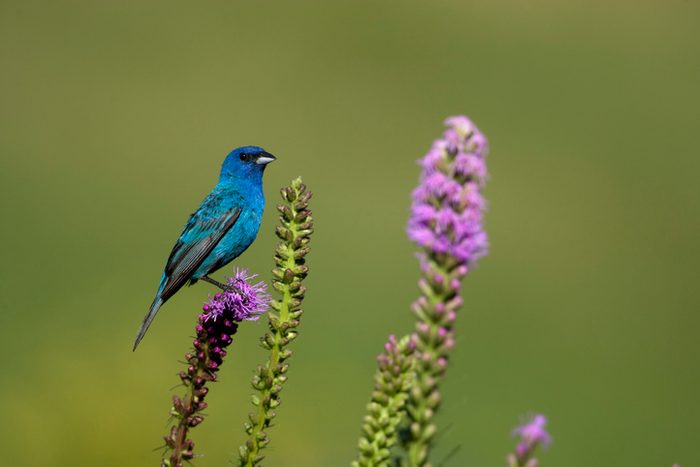
Liatris species, Zones 3 to 9
Many gardeners know these birdseed plants as gayfeather. Don’t be surprised when you see an American goldfinch gripping the purple spikes of the flower head. Blazing star grows up to 5 feet in full to partial sun and blooms in summer.
Coreopsis
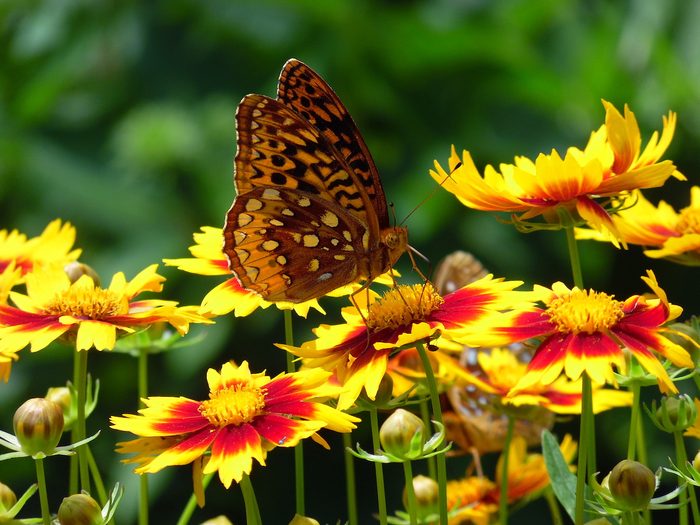
Coreopsis, hardiness varies by variety
It’s not hard to find an annual or perennial coreopsis (also called tickseed) that will flourish in your yard. Plant in full sun and resist the urge to overwater, as it’s a drought-tolerant superstar that blooms in late spring through late summer.
Cosmos
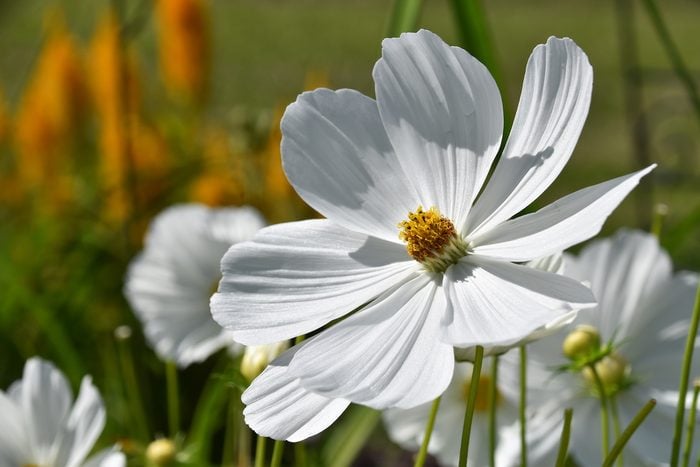
Cosmos bipinnatus, annual
With its gorgeous daisy-shaped blooms, this low-maintenance beauty seems too good to be true. Grow single or double blooms in full sun, and you’ll have cosmos flowers (and seeds to offer feathered friends) from summer through late fall.
Mexican Sunflower
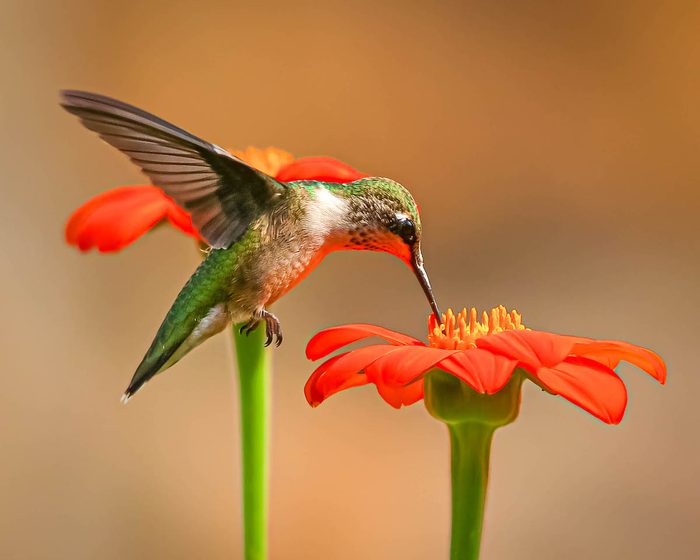
Tithonia rotundifolia, annual
The vibrant, orange flower heads of Mexican sunflower will make a bold statement in any garden. Often mistaken for a zinnia, this sun- and heat-loving plant definitely holds its own when it comes to attracting birds.
Purple Coneflower
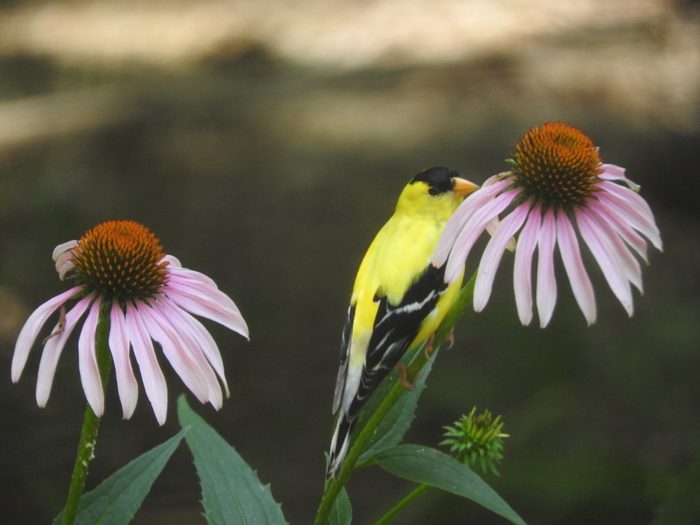
Echinacea purpurea, Zones 3 to 9
Birds will feast on this backyard favorite. New coneflower varieties offer a wide range of colors, including purple, pink, white, yellow and orange. Plant in full sun for gorgeous blooms from midsummer to early fall.
Purple Majesty Millet

Pennisetum glaucum ‘Purple Majesty’, annual
It’s not as familiar to gardeners as other birdseed plants on this list, but your birds will catch on fast! The plant itself is 4 to 5 feet tall, while the flower stalk offers another foot of delectable goodies for birds. Grow in sun or shade to get amazing foliage from spring to fall.
Safflower
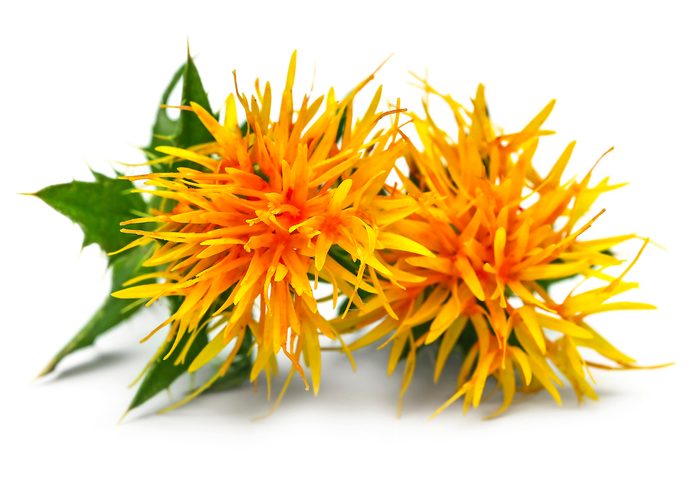
Carthamus tinctorius, annual
Safflower seed is easy to grow and the birds love it! Even if the birds don’t plant it for you, all you need to do is poke some kernels from your seed mix about an inch into the ground in spring. Safflower leaves get spiny as the plant matures. To save your fingers, grow the plant in a casual bed with blue larkspur, bachelor’s buttons, cosmos, marigolds and other easy-care, self-sowing annuals where it can take care of itself.
Even a small planting can keep cardinals, jays, chickadees, titmice, finches, native sparrows and doves investigating all fall and winter.
Why Trust Us
For nearly 30 years, Birds & Blooms, a Trusted Media Brand, has been inspiring readers to have a lifelong love of birding, gardening and nature. We are the #1 bird and garden magazine in North America and a trusted online resource for over 15 million outdoor enthusiasts annually. Our library of thousands of informative articles and how-tos has been written by trusted journalists and fact-checked by bird and garden experts for accuracy. In addition to our staff of experienced gardeners and bird-watchers, we hire individuals who have years of education and hands-on experience with birding, bird feeding, gardening, butterflies, bugs and more. Learn more about Birds & Blooms, our field editor program, and our submission guidelines.
Sources
- The National Audubon Society
- The Cornell Lab of Ornithology, NestWatch
- NATURE documentary series, PBS.org
- Doug Tallamy, professor of entomology and wildlife ecology at the University of Delaware
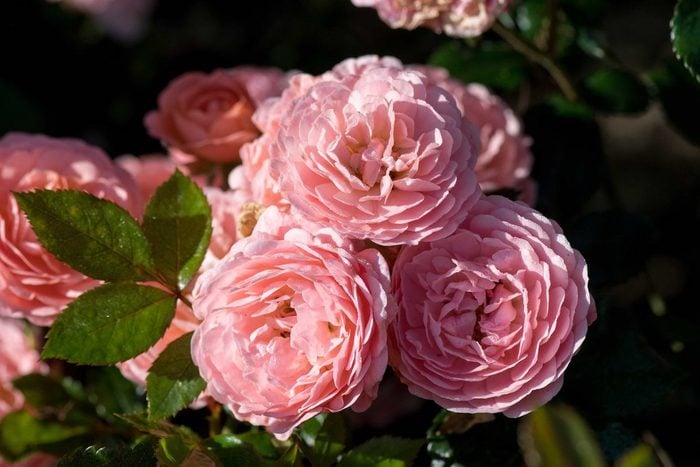
Roses used to be known for requiring so much specialized care that they needed their own section of garden. But today’s breeders are creating roses that blend into our lives and gardens—and Drift roses may become your new favorite.
Discover the best types of roses for every garden.
On This Page
Drift Rose Varieties
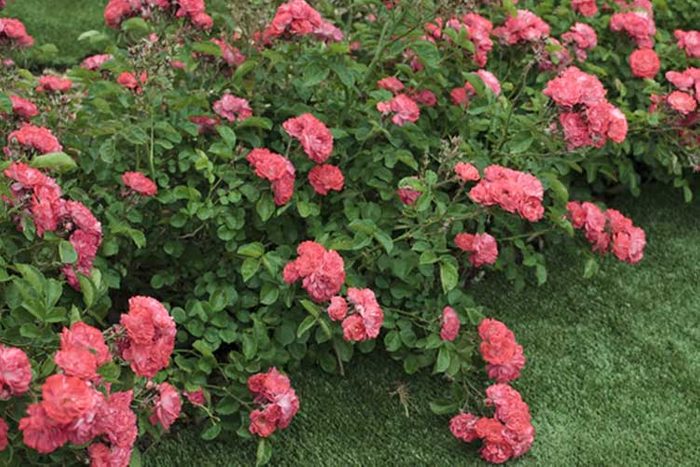
Drift roses arose from a cross between larger ground-cover roses and miniature roses, creating a hearty combination. There are 11 varieties in the Drift series, ranging from white and yellow to apricot, peach, coral and deep rose.
The 1 1/2-inch-wide flowers are plentiful and repeatedly bloom throughout the season. Apricot Drift and Sweet Drift roses are tightly double, resembling a Damask rose.
Discover surprising facts about roses.
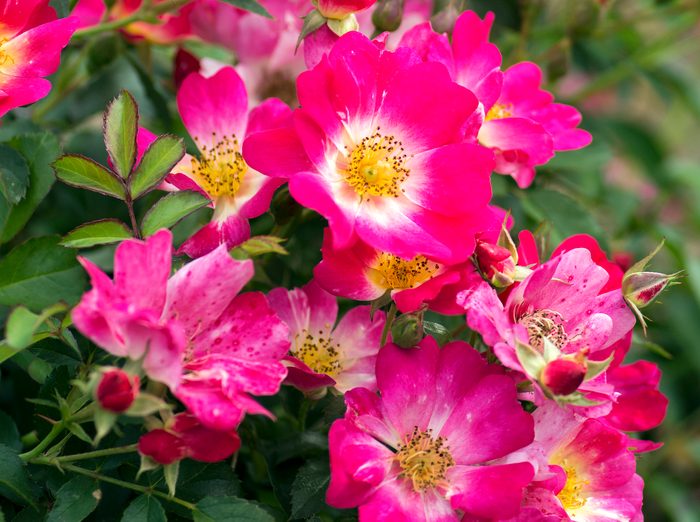
Pink Drift has fewer petals and is more open, revealing gold stamens and a white eye. If you can’t resist a fragrant rose, Peach Drift boasts a floral, honey scent. For a bit of whimsical fun, go with Popcorn Drift for its buttery white and yellow blooms.
The series is listed as hardy in USDA Zones 4 to 11—except for Lemon Drift, which is hardy from 5 to 11—and most are considered disease-resistant.
Learn everything you need to know about Knock Out roses.
Drift Rose Planting and General Care
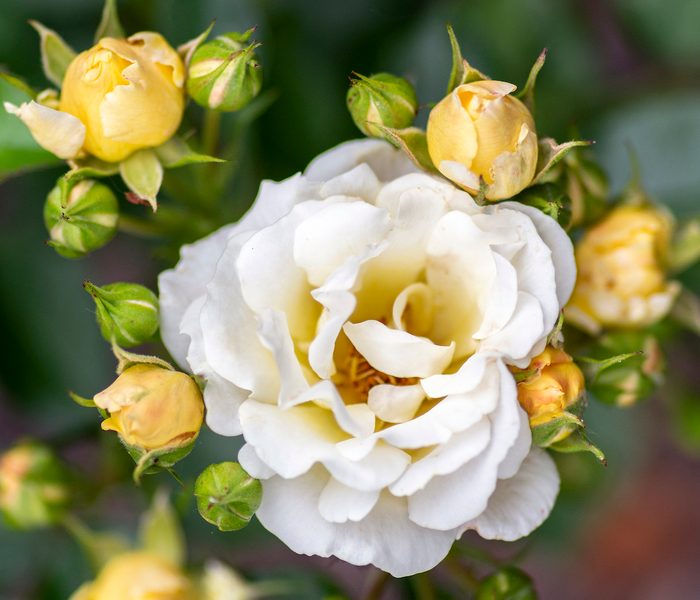
Each Drift rose thrives in six to eight hours of direct sun in moist, well-draining soil.
With one annual pruning, these roses can stay about 1½ to 2 feet high and 2 to 3 feet wide. Simply trim them to about 6 to 8 inches tall before leaves emerge in spring. Also, remove any dead or crossing branches to improve growth and airflow.
Deadheading is not necessary, but you can remove spent blooms if you prefer a tidier look. Without trimming, expect new blooms every five to six weeks until frost.
Only a little is needed in the way of fertilizer too. If desired, the breeders recommend waiting until the rose is established in your garden and has bloomed once. To prevent burning the roots, water the soil first, then add fertilizer and water again. It’s important to stop fertilizing in late summer to allow your rose to slow its growth and prepare for winter.
Floribunda rose vs grandiflora rose: what’s the difference?
Watering Drift Roses
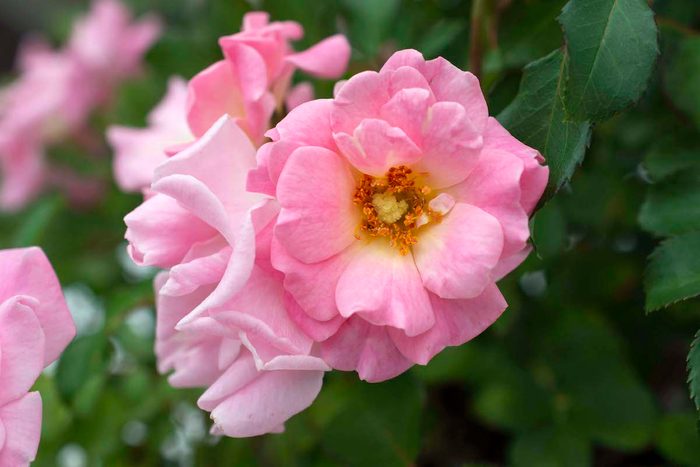
Once established, in-ground plants should do well with a deep watering once a week. Container plants may need watering twice a week or more in hot weather. Give extra water during hot and dry periods, especially during the first season. Watering at the base of the plant rather than overhead watering with a hose or sprinkler promotes healthy growth and can prevent some diseases.
Check out the top 10 fragrant roses to perfume your garden.
Drift Rose Pests and Diseases
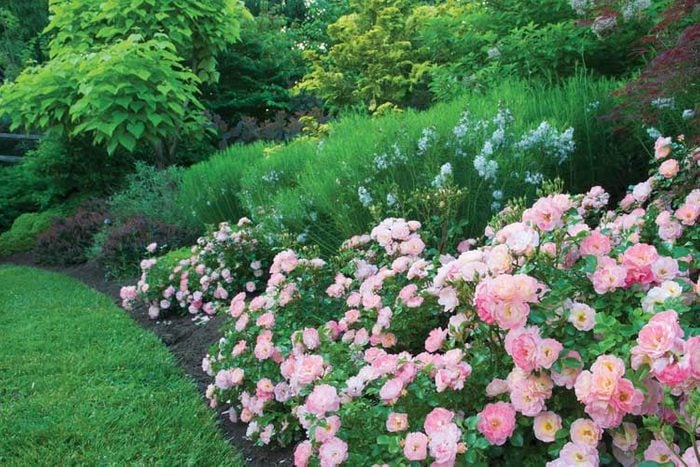
While most of the Drift series of roses has notable disease resistance to black spot and powdery mildew, some sources report occasional incidence of leaf spot, canker, and blight. Pests to look out for include bud borers, spider mites, and Japanese beetles.
Stress, crowded planting, overhead watering, and over-fertilizing, especially with high nitrogen formulations can exacerbate or invite these issues.
Watch for signs of rose rosette disease, which can affect any type of rose. Symptoms include newly thorny canes, persistent red stems and distorted buds. If confirmed, destroy and remove the plant.
Learn how to get rid of rose chafer beetles.
Winter Care in Colder Climates
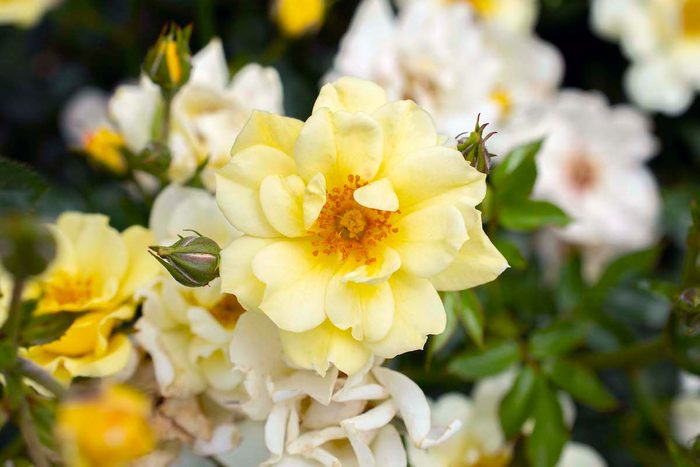
If you’re in the colder portions of Drift roses’ hardiness range, you can give them some extra protection to help during winter. Apply a mulch of 2 to 3 inches of leaves or pine boughs around the base of the plants to help insulate them after the ground freezes. In windy locations, you can wrap your roses in burlap. Remove mulch and burlap in spring at pruning time.
Any Drift roses in containers also need special care because their roots are more vulnerable to the winter’s drying winds and freezing temperatures. Let them go through the first few frost events outside. Then water lightly and bring them inside to a cool, dark area like an unheated garage (or sink the pot, if winter tolerant, into a vacant spot in the garden). Water only enough during the winter to prevent drying out completely, and put them outside in early spring.
Next, find out why roses have thorns (and hips)?
Why Trust Us
For nearly 30 years, Birds & Blooms, a Trusted Media Brand, has been inspiring readers to have a lifelong love of birding, gardening and nature. We are the #1 bird and garden magazine in North America and a trusted online resource for over 15 million outdoor enthusiasts annually. Our library of thousands of informative articles and how-tos has been written by trusted journalists and fact-checked by bird and garden experts for accuracy. In addition to our staff of experienced gardeners and bird-watchers, we hire individuals who have years of education and hands-on experience with birding, bird feeding, gardening, butterflies, bugs and more. Learn more about Birds & Blooms, our field editor program, and our submission guidelines.
Sources
Both Male and Female Cardinals Sing

Did you know? Both male and female cardinals sing! Northern cardinals are one of the few species whose female also sings. A pair might even share cardinal song phrases, using them to communicate at nesting time.
Experts believe the cardinal song duet strengthens their bond. Listen for pure, repetitive whistling from cardinal pairs. Females sometimes call while on the nest. Males bring food to the females as they care for baby cardinals to ensure nesting success.
Do northern cardinals mate for life?
Birds & Blooms readers enjoy hearing and seeing cardinals in the backyard.

“My father passed away recently, and his favorite bird was the northern cardinal. Now this handsome cardinal (above) visits me often, singing his lovely song, and I believe it is a hello from my father,” writes reader Marilyn Diaz.
Find out if cardinal sightings have special meaning.
Hear Cardinal Songs
Listen to the cardinal’s song in the audio clip below.
Bird songs courtesy of the Cornell Lab of Ornithology.
Learn about the differences in male and female cardinal songs by watching this video from the Cornell Lab of Ornithology.
Next, check out the best bird feeders and birdseed for cardinals.
Why Trust Us
For nearly 30 years, Birds & Blooms, a Trusted Media Brand, has been inspiring readers to have a lifelong love of birding, gardening and nature. We are the #1 bird and garden magazine in North America and a trusted online resource for over 15 million outdoor enthusiasts annually. Our library of thousands of informative articles and how-tos has been written by trusted journalists and fact-checked by bird and garden experts for accuracy. In addition to our staff of experienced gardeners and bird-watchers, we hire individuals who have years of education and hands-on experience with birding, bird feeding, gardening, butterflies, bugs and more. Learn more about Birds & Blooms, our field editor program, and our submission guidelines.
Sources
Cornell Lab of Ornithology
On This Page
What Does Verbena Bonariensis Look Like?

“Monarchs flocked to this plant (above) in Mackinac Island, Michigan. What is it?” asks Birds & Blooms reader Charles Miller of Katy, Texas. Horticultural expert Melinda Myers says, “This butterfly magnet is tall verbena (Verbena bonariensis). Its seeds also attract goldfinches later in the season.”
In addition to butterflies and songbirds, keep an eye out for hummingbirds to stop by this plant (which is sometimes called purpletop verbena) that can grow to be 4 feet tall. Plant it in an area with full to part sun for the best season-long displays of purple flowers to draw in pollinators.
- Scientific name: Verbena bonariensis
- Common name: Tall verbena or purpletop verbena
- Light needs: Full sun to part sun
- Zones: 7 to 11 or annual
- Size: 4 feet tall
- Attracts: Birds, butterflies and bees
Verbena Bonariensis Wildlife Benefits

Wisconsin-based master gardener Jennifer Lazewski also emphasizes the benefits of Verbena bonariensis, especially for bees and butterflies. “It does self-seed relatively prolifically at times, but those self-seeding plants hit at the perfect time for monarch migration,” she says. “There are times where I would have four or five clustered in one garden bed on them.”
Jennifer also mentions that it’s a favorite of skipper butterflies and several types of bees, and that she’s been able to take some fun photos of bees on the tall verbena growing in her own garden.
As Melinda noted, Jennifer has also seen goldfinches on the plants. “Occasionally when it’s flowering, they’ll land on it and try to pluck petals from it,” she says.
Discover more long-blooming flowers for attracting butterflies and hummingbirds.
Care and Growing Tips

Tall verbena is a perennial in Zones 7 to 11 and a self-seeding annual in colder areas. Melinda says, “This means you can plant it once and it’ll spread seeds for new plants the following year. Some gardeners find this annoying, while others enjoy the free flowers.”
On the subject of self-seeding, Jennifer notes that standard Verbena bonariensis is quite easy to pull out of garden beds if necessary. In addition, she reminds gardeners that the degree of self-seeding often depends on the amount of the soil covered by other plants and leaves. “If you’re not seeing contact with the soil, you’re not going to have as many re-seeders,” she explains. “If you want re-seeders, you can make sure the soil is bare or shake out the plants.”
Grow tall verbena in containers as a vertical accent, plant it en masse in the garden or allow it to grow through ornamental grasses and other perennials. In addition to full sun, give it a spot in moist, well-draining soil, though it occasionally tolerates dry conditions.
Is Verbena Bonariensis Invasive?
One note of caution from Melinda if you live in the Southeast or parts of the western U.S. and the Northeast. It’s important to know that tall verbena can be considered invasive in these areas. Consult a local native plant expert for alternatives for your area.
Jennifer specifically recommends purple coneflower. “I had a patch of it outside my kitchen window where it got the morning sun,” she says. “I used to regularly have butterflies on it because they’d be basking in the sun and building up their temperature.”
Look for Non-Invasive Varieties

If self-seeding is a concern for you, Melinda says newer compact varieties such as Meteor Shower produce far fewer seeds.
Proven Winners media coordinator Jeanine Standard mentions that Meteor Shower verbena offers all the benefits of tall verbena, without some of the drawbacks. Its smaller size makes it easier to plant in containers and less susceptible to being blown over by strong winds. But it boasts the same pollinator benefits.
Its low-maintenance nature and vibrant flowers make it a perfect pick for a gardener with less space, or one concerned about excessive and invasive self-seeding. “Instead of putting its energy toward producing seed, it puts its energy toward producing better flowers,” Jeanine explains.
Why Trust Us
For nearly 30 years, Birds & Blooms, a Trusted Media Brand, has been inspiring readers to have a lifelong love of birding, gardening and nature. We are the #1 bird and garden magazine in North America and a trusted online resource for over 15 million outdoor enthusiasts annually. Our library of thousands of informative articles and how-tos has been written by trusted journalists and fact-checked by bird and garden experts for accuracy. In addition to our staff of experienced gardeners and bird-watchers, we hire individuals who have years of education and hands-on experience with birding, bird feeding, gardening, butterflies, bugs and more. Learn more about Birds & Blooms, our field editor program, and our submission guidelines.
Sources
- Proven Winners
- University of Wisconsin-Extension Master Gardeners
- Melinda Myers, official gardening expert for Birds & Blooms
On This Page
Why Are My Irises Not Blooming?

“What would cause iris plants not to bloom two years in a row? Three years ago they bloomed,” asks Birds & Blooms reader Rosemary Dzatko of Cuyahoga Falls, Ohio.
Horticultural expert Melinda Myers writers, “It’s always frustrating when our flowers don’t perform as expected.” Here are some likely reasons why your irises are not blooming.
Learn more about Iris flower types and facts.
Irises Are Overcrowded

Overcrowded iris plants often fail to bloom. If this is the case, try dividing the irises this coming summer. Keep in mind that recently divided and transplanted irises may not flower for a year or two after the move.
Learn how to grow walking iris in containers.
Not Enough Sun
Insufficient light caused by increased shade from maturing trees, nearby plantings and new structures can also reduce or prevent iris blooming. Move iris plants to a sunnier location if needed.
Frost Damage on Irises
In addition, a late spring frost can damage the emerging flowers and prevent iris blooming. Tracking the weather often provides clues to problems in the garden.
Excessive Heat
“Every spring when the yellow flag iris (Iris pseudacorus) in my fish pool blooms, the flowers stay wedged in the base of the leaves instead of coming up on stems. What causes this?” asks reader Irene Holzman of Pensecola, Florida.
Melinda says, “Environmental stress can cause the stunting of flower stalks. Make sure the rhizomes have plenty of room to grow. Excessive heat and sun in hot climates like yours can also stress these plants.”
Backyard Tip: Yellow flag iris is an invasive perennial and is considered a noxious weed in many states. Look for native blue flag iris instead.
Why Trust Us
For nearly 30 years, Birds & Blooms, a Trusted Media Brand, has been inspiring readers to have a lifelong love of birding, gardening and nature. We are the #1 bird and garden magazine in North America and a trusted online resource for over 15 million outdoor enthusiasts annually. Our library of thousands of informative articles and how-tos has been written by trusted journalists and fact-checked by bird and garden experts for accuracy. In addition to our staff of experienced gardeners and bird-watchers, we hire individuals who have years of education and hands-on experience with birding, bird feeding, gardening, butterflies, bugs and more. Learn more about Birds & Blooms, our field editor program, and our submission guidelines.

Want to do something that’s good for bluebirds—and fun for you? Learn how to build a DIY bluebird house! You’ll be charmed by the brilliant birds’ beauty and their cheerful singing… not to mention adorable baby bluebirds. Since their diet consists primarily of insects and grubs, your garden may benefit, too.
Check out our guide to feeding mealworms to birds.
In the past, bluebirds relied on woodpeckers and other cavity-dwellers to provide the majority of their nesting places. They’d select abandoned cavities in dead trees or rotten fence posts to raise their families. As development wiped out many of these natural nesting sites, the bluebird population declined dramatically.
But nesting boxes have played a vital role in reviving the beloved bluebird. They have fairly specific requirements, so these DIY bluebird house plans are designed to meet their needs.
Here’s more tips on how to attract bluebirds to your backyard.
On This Page
Tips for Attracting Bluebirds to Nest Boxes
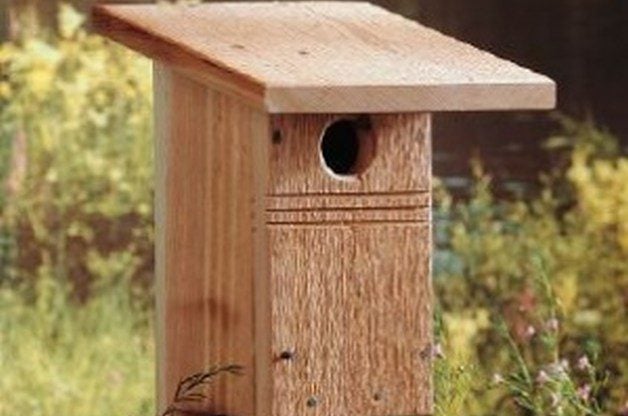
Bluebirds prefer to nest in open areas with low or sparse ground cover. The North American Bluebird Society, which provided the plans, says rural areas, cemeteries, golf courses and parkways with minimal human traffic are good places to mount bluebird boxes. Simply drive a 3/4-inch piece of electrical conduit into the ground and attach the house 5 feet above the ground with conduit straps as shown at right. Attach a predator guard to deter nest raiders.
This bluebird house has a couple of interesting features worth pointing out. It’s assembled with the rough side of the wood facing out so it more closely resembles the birds’ natural nesting sites. And there’s no perch. Notches beneath the entrance hole provide footing for bluebirds, but discourage visits from competing house sparrows and wrens.
The swing-open side is convenient, also. You can check for nests of unwanted birds (since house sparrows and European starlings are not protected by law, simply remove their nests) and have easy access for cleaning out the bluebird’s nesting materials after the young have fledged. You’ll want to do this immediately, since bluebirds often raise as many as three broods in one nesting season.
Best of all, the swing-open side will give you a chance to peek in on the nestlings for whom you’ve provided a sturdy and safe home. The side door is great for monitoring the activity in these bluebird houses.
Bluebird House Specifications

- An entrance hole of 1 9/16 inches will safely entice eastern, mountain or western bluebirds. However, it’s best to look up specific nest box details for your local bluebirds.
- Stick with plain wood boxes offering good ventilation.
- Look for options with sloped roofs that overhang the entrance to keep water out.
- Either buy a nest box with drainage holes on the bottom or drill a few yourself.
- Be sure to select a nest box with easy access for cleaning after a brood has fledged.
Bluebird House Materials
- One 4-foot 1-inch x 6-inch rough cedar board
- One 10-1/2-inch 1-inch x 10-inch rough cedar board
- 2-inch finishing nails
- 1-5/8-inch galvanized deck screws
- 8 feet of 3/4-inch conduit and two straps
- Table saw
- Power drill
Step-by-Step Bluebird House Plans and Instructions
Step 1
Using the full width of a 4-foot 1-inch x 6-inch rough cedar board, cut the pieces as pictured in the board layout below. When making the angled cuts, keep in mind that all the pieces will be assembled rough side out.

Step 2
Drill a 1-1/2-inch entrance hole in the front piece with a spade bit for eastern and western bluebirds. In areas where mountain bluebirds reside, drill the entrance hole 1-9/16 inches. Center the hole about 1-1/2 inches from the top of the board.
Step 3
Starting about 1/2 inch below the entrance hole, make three shallow cuts about 1/4 inch apart on both sides of the front board. On a table saw, set the blade at 1/8 inch deep and use the saw’s miter gauge to cut the notches. Flip the piece over and make identical cuts on the other side. If you want the front board to fit flush with the roof, cut an optional angle along the top edge by tilting the table saw blade 12 degrees.
Step 4
Position the sides flush with the top of the front board. Fasten the right side to the front with two 2-inch finishing nails. Fasten the left side to the front with a 1-5/8-inch deck screw near the top (drill a pilot hole first). Be careful not to over-tighten this screw because it will serve as a hinge for the side door.
Step 5
Cut an optional 12 degree angle along the top edge of the back piece if you want it to meet flush with the roof. Then place the assembled front and sides on top of the back piece, leaving the top of the back board 1/4 inch higher than the sides. The space provides ventilation.
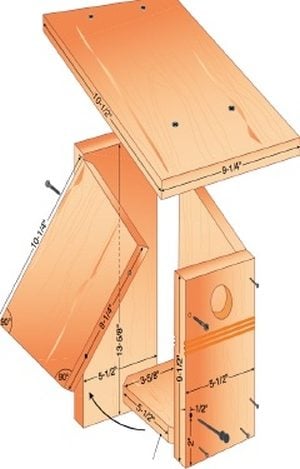
Step 6
Turn the box over and attach the back to the left side of the box (the one with the “hinge”) with a 1-5/8-inch deck screw. Drill a pilot hole first directly opposite the screw on the front (this ensures proper hinge action) and fasten with a screw. Again, don’t make it too tight. Secure the other side to the back with three 2-inch finishing nails.
Step 7
Cut about 1/2 inch off each corner of the floor to provide drainage. Position the floor 1/4 inch up from the bottom of the nest box. (Recessing the floor helps keep the box dry.) Attach the floor with 2-inch finishing nails on the front, back and right side. Do not use nails through the “hinged” left side or you won’t be able to open it.
Step 8
Drill a hole on the hinged side 2 inches up from the bottom and 1/2 inch in from the side. Drill at a slight downward angle, going through the front of the house and into the side. Make the hole large enough for a double-headed nail to slip in and out easily. Insert the nail to hold the side door closed.
Align the roof flush with the back and attach with 1-5/8-inch deck screws (drill pilot holes first).
Step 9
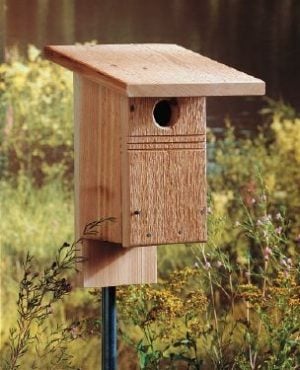
The nest box is ready to mount. Keep the entrance hole about 5 feet above ground.
The Bluebird Society recommends attaching your bluebird box to a smooth round pipe, such as a 3/4-inch electrical conduit, rather than on a tree or fence. Conduit straps attached to the back work well for mounting. For extra protection from predators, put hardware cloth under the box to deter snakes.
Face the bluebird box away from prevailing winds and towards a tree or shrub no more than 100 feet away. This will provide a landing spot for young birds when they first leave the box.
Next, learn how to build a one-board DIY birdhouse.
Why Trust Us
For nearly 30 years, Birds & Blooms, a Trusted Media Brand, has been inspiring readers to have a lifelong love of birding, gardening and nature. We are the #1 bird and garden magazine in North America and a trusted online resource for over 15 million outdoor enthusiasts annually. Our library of thousands of informative articles and how-tos has been written by trusted journalists and fact-checked by bird and garden experts for accuracy. In addition to our staff of experienced gardeners and bird-watchers, we hire individuals who have years of education and hands-on experience with birding, bird feeding, gardening, butterflies, bugs and more. Learn more about Birds & Blooms, our field editor program, and our submission guidelines.
Sources
- North American Bluebird Society
- NestWatch
- Reviewed by Kenn and Kimberly Kaufman, official birding experts for Birds & Blooms
